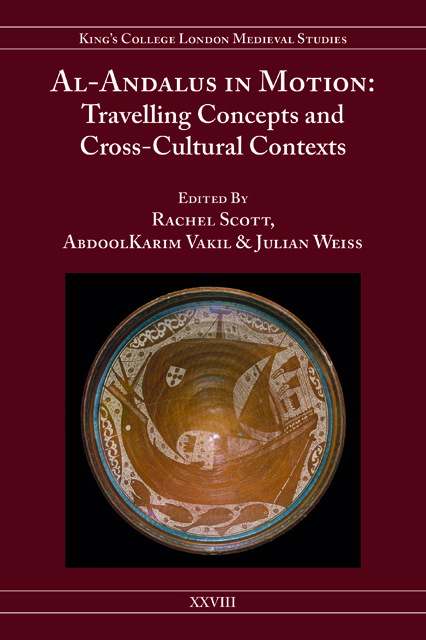Book contents
- Frontmatter
- Contents
- List of Illustrations
- Acknowledgements
- Notes on Contributors
- Part I Departure Points
- Part II Translating Al-Andalus: Travelling across Languages
- Part III (Re)Visions of Al-Andalus in Diaspora and Exile
- Part IV Andalusi Space as Node and Utopia: Europe, Islam, Empire
- Part V Al-Andalus and the Politics of Religious Identity
- Part VI Legacies, Landscapes and ‘Travel Buildings’
- Epilogue
- Index
1 - Al-Andalus in Motion: Paths and Perspectives
Published online by Cambridge University Press: 02 June 2023
- Frontmatter
- Contents
- List of Illustrations
- Acknowledgements
- Notes on Contributors
- Part I Departure Points
- Part II Translating Al-Andalus: Travelling across Languages
- Part III (Re)Visions of Al-Andalus in Diaspora and Exile
- Part IV Andalusi Space as Node and Utopia: Europe, Islam, Empire
- Part V Al-Andalus and the Politics of Religious Identity
- Part VI Legacies, Landscapes and ‘Travel Buildings’
- Epilogue
- Index
Summary
At the end of In the Glow of the Phantom Palace: Travels from Granada to Timbuktu, a travelogue commissioned by the cultural foundation El Legado Andalusi to promote Andalusia's Islamic heritage, Michael Jacobs recounts how Mahmud, a Malian scholar who is himself conducting research into his country's connections to Andalusia, entices him to travel to Timbuktu to meet an elderly descendant of the Andalusis. Just when Jacobs is about to give up and leave after the meeting proves far from informative, the old man asks him a question: does he know a man called Mahmud who has often come to see him? ‘Mahmud’, the old man continues, ‘is always talking to me about this extraordinary place in Spain called the Alhambra’, adding, ‘But what is this Alhambra? Is it a public park, a fun-fair, a zoo?’ (Jacobs 2000: 249). Jacob's half cautionary, half tongue-in-cheek anecdote illustrates the protean quality of the Alhambra, which, like many other splendours of al-Andalus, or medieval Iberia under Muslim rule, enables the continuous circulation and reinscription of images and meanings, until source and echo cannot be told apart. And yet, at the same time, the Alhambra really is all that; and more: it is theatres and cinemas, and bull-fighting rings and bingo halls, and synagogues and palaces, and much more besides.
In a 1996 landmark interview, the Palestinian poet Mahmoud Darwish called attention to the fluidity that defines al-Andalus: it ‘might be here or there, or anywhere’, he said, ‘a meeting place of strangers in the project of building human culture’ (Yeshurun 2012: 51). This resonates within Darwish's poetry too. In ‘Eleven Stars over Andalusia’, composed for the Quincentenary of 1492, the poet wonders ‘Was Andalusia here or there? On the land … or in the poem?’ (Darwish 1994: 101). In his interview, Darwish specifically places the relation he established in this poem between al-Andalus and Palestine against the comparison: ‘we lost Palestine just as we lost Andalus’, cultivated by popular Palestinian poetry of the 1950s and 1960s. Instead, he argues, ‘Andalus may return’ (Yeshurun 2012: 51). A decade later, Gil Anidjar would similarly ask whether there was ‘an “unfinished project” for al-Andalus, for al-Andalus as a figure if not of modernity, at least of incompletion, even perhaps of infinity?’ (2006: 225).
- Type
- Chapter
- Information
- Al-Andalus in MotionTravelling Concepts and Cross-Cultural Contexts, pp. 23 - 52Publisher: Boydell & BrewerPrint publication year: 2021

